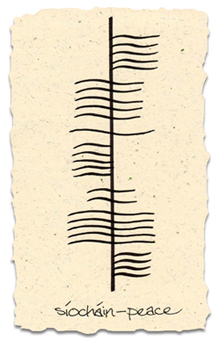 With another St. Patrick’s Day upon us this weekend, it seems a fitting time to share my longstanding fascination with Ogham, an ancient form of writing dating back to 5th century Ireland.
With another St. Patrick’s Day upon us this weekend, it seems a fitting time to share my longstanding fascination with Ogham, an ancient form of writing dating back to 5th century Ireland.
Ancient Ogham inscriptions were carved in stone or wood, and read from bottom to top. It is sometimes referred to as the “tree alphabet”, since each of the twenty main letters in Ogham’s phonological alphabet is given the name of a tree. Each of these trees has a sacred meaning in the Celtic religion.
The exact origin of this form of writing is uncertain, but many believe it was inspired by Ogma, the “god of eloquence “. Some researchers believe that the symbols used in Ogham were adapted from a ritualistic sign language, with Ogham’s characteristic lines attached to a stemline being taken from the display of fingers from a hand.
For those interested in learning more, Wikipedia provides a comprehensive definition and history of this unique form of writing, including the descriptions shown here to the right. (mouseover the forms’ names)
In the handwritten example I’ve provided above, I took the liberty of mixing the “classical” vertical format of Ogham carved inscriptions with a “modern” script and a stylized treatment. However, much of the Ogham that appears on paper today is written in a horizontal, left-to-right format and uses simple straight lines.
If you want to try some experimenting of your own with Ogham, you can download some free Ogham fonts, courtesy of evertype.com.
Happy St. Patrick’s Day to all!
Author’s note: My Ogham example conveys a wish for lasting peace in Ireland this year. After far too much bloodshed, we are given hope by the recent news out of Ireland and the recent rise in the use of words instead of arms to resolve differences within the region. May this change continue, and may the rest of the world take note.

